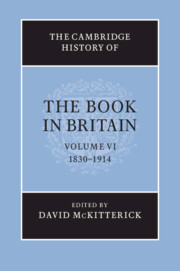Book contents
- Frontmatter
- Introduction
- 1 Changes in the look of the book
- 2 The illustration revolution
- 3 The serial revolution
- 4 Authorship
- 5 Copyright
- 6 Distribution
- 7 Reading
- 8 Mass markets: religion
- 9 Mass markets: education
- 10 Mass markets: children’s books
- 11 Mass markets: literature
- 12 Science, technology and mathematics
- 13 Publishing for leisure
- 14 Publishing for trades and professions
- 15 Organising knowledge in print
- 16 The information revolution
- 17 A place in the world
- 18 Second-hand and old books
- 19 A year of publishing: 1891
- 20 Following up The reading nation
- Bibliography
- Index
- Plate Sections
- References
2 - The illustration revolution
Published online by Cambridge University Press: 28 March 2010
- Frontmatter
- Introduction
- 1 Changes in the look of the book
- 2 The illustration revolution
- 3 The serial revolution
- 4 Authorship
- 5 Copyright
- 6 Distribution
- 7 Reading
- 8 Mass markets: religion
- 9 Mass markets: education
- 10 Mass markets: children’s books
- 11 Mass markets: literature
- 12 Science, technology and mathematics
- 13 Publishing for leisure
- 14 Publishing for trades and professions
- 15 Organising knowledge in print
- 16 The information revolution
- 17 A place in the world
- 18 Second-hand and old books
- 19 A year of publishing: 1891
- 20 Following up The reading nation
- Bibliography
- Index
- Plate Sections
- References
Summary
The nineteenth century brought illustrated books and periodicals to large sectors of the British population for the first time. The task fell jointly on the printing, publishing and allied trades, which responded organisationally, technologically and creatively to the demands made on them. In doing so they contributed substantially to the impact pictures in general had on society. Initially, Britain was at the forefront of the many advances in printing and publishing that brought this about, but as the century progressed its influence waned. On technical matters, for example, the initiative passed to Germany and the United States in the second half of the century, particularly in photo-mechanical reproduction and chromolithography.
The first serious efforts to bring large numbers of illustrated publications within the pockets of ordinary readers were made in Britain in the 1830s with the rise of pictorial journals, particularly the Penny Magazine (founded 1832). From then on the story is one of wider dissemination across an increasingly broad range of books and journals, greater and faster production, and a steady improvement in the technical quality of pictorial reproduction. The range embraced publications for enjoyment, including children’s books, books relating to travel and natural history, popular literature and leisure magazines, in addition to others intended for information and elucidation, such as technical manuals, guidebooks, schoolbooks on certain subjects, catalogues, scientific monographs and journals, and encyclopaedias.
Keywords
- Type
- Chapter
- Information
- The Cambridge History of the Book in Britain , pp. 117 - 143Publisher: Cambridge University PressPrint publication year: 2009
References
- 3
- Cited by



